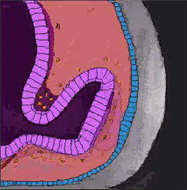 The
eye is a complex organ of special sense.
The eye is derived from an outpocketing of the early embryonic brain
and its unique and highly complex structure reflects its origin. In
studying a histological section of the eye, one must keep in mind
the fact that, in the living state, the anterior portion of the eye
is filled with fluid which is being continually produced and
absorbed.
The animated image to right is courtesy
of
Loyola University of
Chicago, and demonstrates the developmental stages of the human
eye. The
eye is a complex organ of special sense.
The eye is derived from an outpocketing of the early embryonic brain
and its unique and highly complex structure reflects its origin. In
studying a histological section of the eye, one must keep in mind
the fact that, in the living state, the anterior portion of the eye
is filled with fluid which is being continually produced and
absorbed.
The animated image to right is courtesy
of
Loyola University of
Chicago, and demonstrates the developmental stages of the human
eye.
- Thank you, a little of that goes a
long way.
The learning objectives for this
unit are:
- Identify and distinguish the
three concentric layers of the eyeball histologically.
- Identify the internal chambers,
fluid contents (vitreous and aqueous humors), and associated
structures and smooth muscles of the eye.
- Recognize the microarchitecture
of the accessory structures of the eyes; eyelids, conjunctiva,
and lacrimal glands.
Let's now look at some
particulars of the eye. |